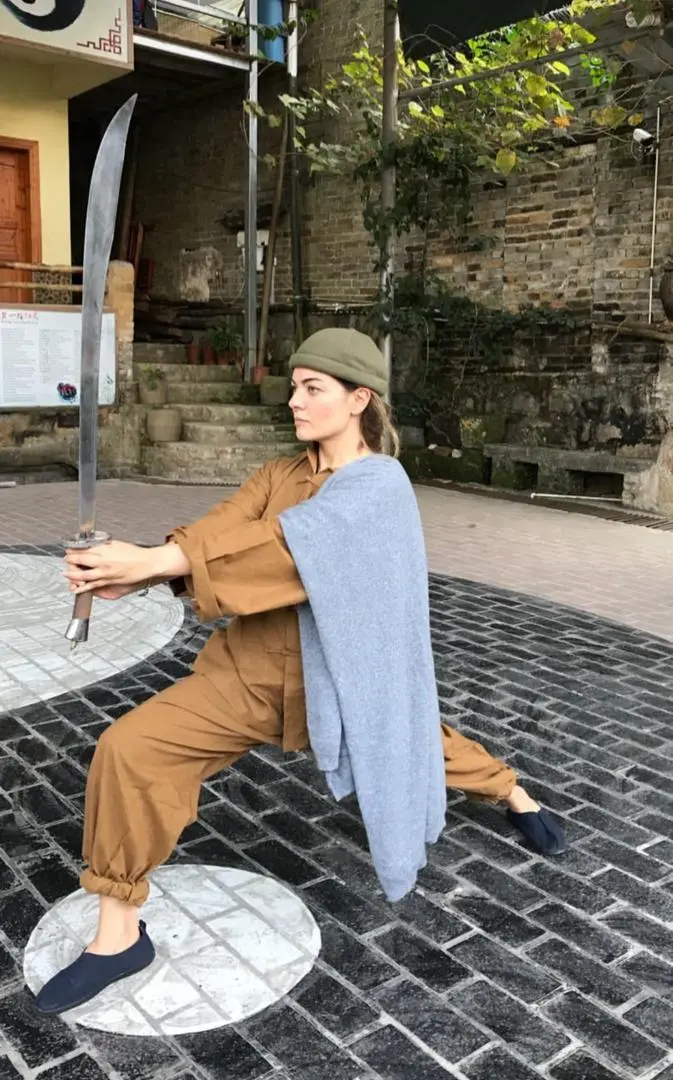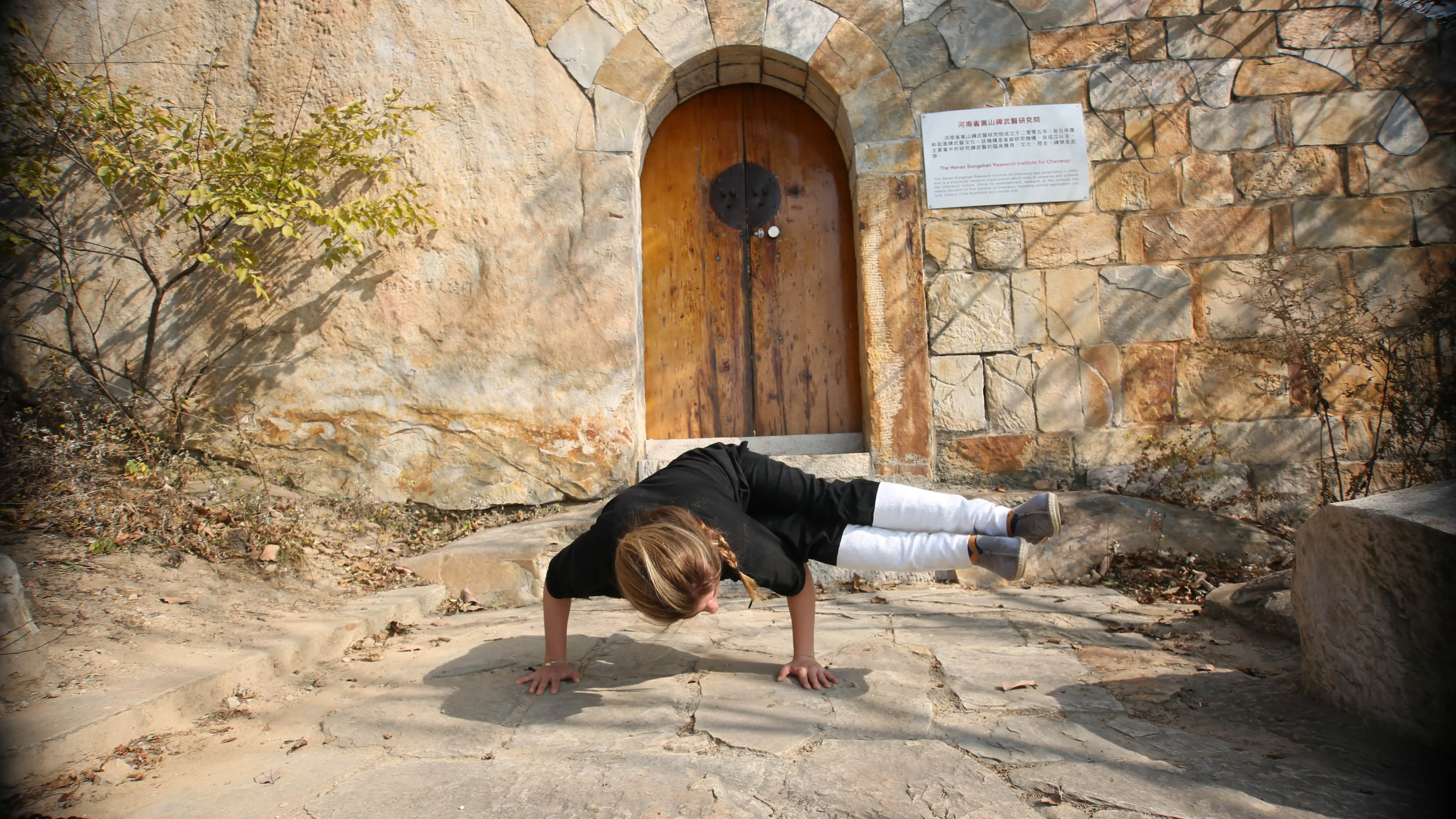The story of the journey to China is so long that I don’t know where to begin. It starts with my mother. All the time spent finding classes and instructors, taking me to classes, worrying about finding my path in life, and all these activities were part of the daily hustle of life. In the 60s, when martial arts classes were somewhat informal, my mother found an instructor who taught girls, and I trained alongside the boys. Kung Fu was my mother’s discovery, as she believed this sport could help me release a lot of energy and, at the same time, improve my focus.
I heard about the Shaolin Temple and its masters during those same classes. The desire to go to Shaolin and learn from those masters existed in the hearts of all of us teenagers in that class, but it was so out of reach that we contented ourselves with watching action movies. Seeing the Yin and Yang symbol marked the beginning of a phase in my life when one of the disciples had attached it to the wardrobe in the school. Learning the basics of ancient Chinese philosophy took a lot of work; almost all the books published in this field were forbidden. New books couldn’t be written, or if they were, I, as a teenager, didn’t have access to them. The internet also came much later; I only discovered that Kung Fu encompasses intricate cosmology.
Discovering Ancient Chinese Philosophy
They consider the concept of Yin and Yang to be the law of Chinese thinking. According to this philosophy, existence is shaped by these two opposing forces. Yang represents brightness, dryness, and positive forces, while Yin represents darkness, moisture, and hostility. Although Yin and Yang may seem opposing, they are complementary and interdependent, symbolizing the cosmic changes from Yang to Yin and vice versa. In this mythological perspective, the transformation of seasons also adheres to this principle. The two complementary circles of Yin and Yang, each containing a point of the other within itself, symbolize the coexistence and unity of these two forces.
My limited knowledge led me to become interested in Tai Chi. Practicing Tai Chi provided me with more focus and balance. In the Yin and Yang school, “Qi” is the cosmic energy and life force that exists. Tai Chi is the same as Chaos, and everything exists within the heart of this Chaos. Chaos transforms into Yang, and Yin is born from the heart of Yang. In other words, Tai Chi can be seen as the ultimate greatness that, through its movements, brings the universe into existence and imparts dynamism to it.
Understanding the concept of Yang representing masculine energy and Yin representing feminine energy can be challenging, especially at a young age, and it continues to pose difficulties for me even now. Every term I discovered has taken me a step further. In ancient Chinese philosophies, the universe is said to be formed from metal, wood, water, fire, and earth, referred to as Wuxing. Engaging with these myths is not about rejecting or accepting them but a form of observing traditions. This pilgrimage through ancient Chinese rituals has shown me that there is logic and functionality behind traditions. The functionality of these thoughts may have diminished over time, but the mythical world remains intertwined with the everyday life system. The pentagon of Chinese thinking even extends into the ethical and political system. In the Confucian ethical system, everything is based on the five virtues of humanity: justice, courtesy, loyalty, and trust. There is a direct connection between these five virtues and the natural elements.

Observations in Modern China
My journey in China began with a big shock. Busy, traffic-packed Beijing, with polluted air and somewhat irritable people. At the airport, I underwent a detailed interrogation. Despite the high tourism rate in China, my sincere answer, which was to meet the masters of the Shaolin Temple, became a troublesome matter. They found something suspicious, but eventually, I obtained entry permission. I flew to Shanghai and reached the Shaolin Temple by train. What intrigued me was the temple schools. I spent a night in one of these temples. Students were accepted into these temples from the age of five. They woke up at five in the morning, cleaned the environment, and then engaged in rigorous martial arts training in the open space. My journey was in the fall, and the cold was peculiar. Besides regular school subjects, these kids also underwent a series of rigorous exercises. Military-style life encompassed all aspects: hard work, rationed food, and a schedule for all hours of the students. They could only play for one hour a day because other children had to engage in games. In a country where mass production is its most important characteristic, these schools were responsible for producing many athletes. Athletes who, in the future, would become young men and had to bring home Olympic medals.
There were two lifestyles in the Shaolin Temple: the life of the monks and the life of the tourists. The temple is one of the most visited tourist destinations in China. These two lifestyles have significantly influenced each other. Tourists get acquainted with a new way of life, and temple monks become familiar with different cultures. These commercial transformations may be at the heart of historical changes that China has undergone over the past hundred years. These changes may have led to significant alterations in the lifestyle of these temples.

The trip to China was spent visiting various temples. Those teachings that link philosophy with martial arts were no longer known in the Shaolin Temple. Martial arts were taught as a sport, lacking the spiritual unity of body and mind and the guidance of a master to help the disciple understand the secrets of existence. In another calm and small temple, I encountered a Tai Chi master. I practiced yoga and meditation with him in nature, and he allowed me to film his martial arts. These were temples that tourists were not allowed to enter, as a strong fortress guarded them. These temples welcomed enthusiasts, and there were also wholly tourist-oriented temples.
I have always been satisfied with every trip, as I was with China. All my dreams fell apart. On that trip, everything was in decline; modern China had severed ties with a significant part of ancient Chinese thinking. I observed a world of competition without connection to internal discipline and self-control. As one of ancient China’s fundamental characteristics, respect had given way to fear. The balance derived from understanding nature and discovering oneness with it was impossible in China’s bustling and densely populated cities. Gradually, the concept of decline was taking shape in my mind. Globalization erodes nature, indigenous cultures, and ancient traditions that embody the systematic thinking of humanity’s past.
You had eagerly anticipated this journey, having read, practiced, questioned its rituals, and developed belief. The cycle of doubt and faith continues, and your disappointment is short-lived. It’s because ancient Chinese philosophy has instilled a principle in my life that I have constantly assessed in proximity or distance to it: embracing existence and its changes, recognizing myself as a tiny part of the vast cosmos, making peace with the fact that we are not the center of the universe, and acknowledging life as a cyclical process: from childhood to adulthood, from rawness to maturity, from immaturity to wisdom. While embracing and surrendering to nature, something should position us against the coercion of nature—a desire for change, hope, and the aspiration to build a better world. This delicate and fragile balance tends to tilt individuals in one direction or another, yet my constant measure is balance. I hope that we all find a fragment of equilibrium in exploring personal and collective insights in the threads of these writings and shared experiences. A hope is distant but, in my view, attainable.





